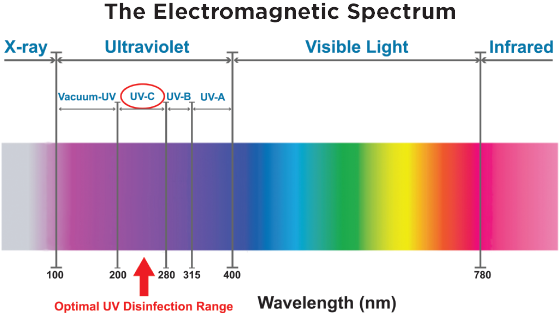HOME / ARTICLES / UVGI TECHNOLOGY AT A GLANCE

UVGI TECHNOLOGY AT A GLANCE
03.29.2018
Ultraviolet rays are part of electromagnetic radiation bounded by the lower wavelength extreme of the visible spectrum and the upper end of the X-ray radiation band. The spectral range of ultraviolet radiation is between 100 and 400nm (1nm=10-9m) and is invisible to human eyes.
The UV spectrum is subdivided into three bands:
UV-A (long-wave) from 315 to 400 nm
UV-B (medium-wave) from 280 to 315 nm
UV-C (short-wave) from 100 to 280 nm
The portion of the UV spectrum (the “disinfecting” region) that is relevant for disinfection is the range that is absorbed by DNA (RNA in some viruses). This “disinfecting range” is approximately 200 – 300 nm, with a peak of germicidal effectiveness at about 265 nm.
Absorption of a UV photon by a DNA chain of a dangerous microorganism disrupts a link and, consequently, inhibits DNA replication.
265,0 nm peak of disinfectant effect
253,7 nm standard UV-C bulbs
280,0 nm LED wavelength (NEW!!)
There are different types of lamp. The discharge lamp emits light by luminescence from an ionized gas. The ionization of the gas is obtained through a potential difference, which migrates free electrons and positive ions to the different ends of the lamp (where there are electrodes).
Low-pressure UV lamps. These offer high efficiency (approximately 35% UV-C) but low power, typically 1 W/cm (energy per arc length unit). They produce ultraviolet radiation at 254 nm.
UV amalgam lamps. A high-power version of low-pressure lamps. Their efficiency is slightly less than traditional low-pressure lamps (approximately 33% UV-C), and the power density is about 2-3 W/cm. They operate at high temperatures and have a lifetime of up to 16000 hours.
Medium-pressure UV lamps. These lamps have a spectrum with a pronounced peak and high radiation production but a low efficiency of 15% or less for UV-C. They produce polychromatic light from 200 nm up to visible and infrared light. The typical power density is 30 W/cm³ or larger. Low-pressure and amalgam lamps emit light at 254 nm and 185 nm (by oxidation) depending on the quartz glass used for the lamp body. Light at 185 nm is used to produce ozone.
All these UV-C sources are exhausted both by the “discharge” of the gas contained within the bulb and by the progressive loss of transparency of the glass that forms them, in which electrons are deposited.
This is the typology.
The UV-C lamps can be divided into:
Common UVGI lamps
High output (HO)
Amalgam
Medium pressure
Ozone
LED UV-C.
LED NEW TECHNOLOGY
The most innovative source of ultraviolet rays is UV-C LEDs. These microscopic UV light sources can achieve the same results as standard UV lamps while offering extreme portability, power, and applicability features. Due to their recent implementation, it is now possible to design novel products for the sanitization of water and surfaces. These products could not even be imagined until a few years ago.
UV-C Light Emitting Diodes (LEDs).
LEDs are optoelectronic devices that exploit the properties of semiconductor materials. They consist of three layers:
The so-called N layer contains electrons.
The player, with gaps (i.e., positive charge carriers).
An intermediate layer (the active layer) consists of a semiconductor.
Electrons combine with the holes by applying a voltage to the n and p layers and emit photons – i.e., LIGHT.
Unlike traditional light sources, whose output wavelength is fixed, UV LEDs can be manufactured to operate at the optimum wavelength for the application.
265nm is widely recognized as the peak absorption of DNA; however, 275-280 nm is widely used for its excellent stability.
UV LEDs also switch on and off instantly and can be pulsed without any detriment to their lifetime, making them more user-friendly and safer for the operator. The design rules for UV LEDs open new opportunities for what can be disinfected: we are no longer limited to a long tube but can mount the LEDs in flat panels; on flexible circuit boards; on the outside of cylinders; the options are almost endless
UV-C LED: NO HEAT, WAVELENGTH SELECTION, INSTANT POWER, MERCURY FREE, DESIGN EXTREME FLEXIBILITY
Vs
UV-C lamp: LOW POWER, UNCERTAINTY IN TECHNICAL VALUES, PRICE, RELIABILITY, DESIGNED-PER-VOLUME.
